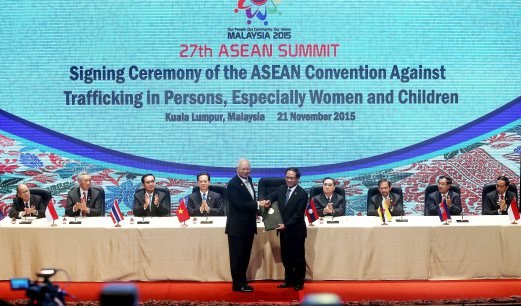Given the ongoing fallout of Chinese land reclamations in the South China Sea and the recriminations from other littoral states and external stakeholders, it was no surprise that the issue was raised again at the 27th Asean Summit. The usual criticisms, accusations and calls for restraint directed towards China were met with the latter’s predictable counter-criticisms and accusations in response. Both United States President Barack Obama and Japanese Prime Minister Shinzo Abe kept their word of highlighting Chinese violations “wherever and whenever” necessary. Asean foreign ministers who met on Nov 20 also issued a joint statement saying they were “seriously concerned” over the land reclamations.
While coverage over the latest spats and accusations over the South China Sea generally tend to grab headlines, we would do well to remember that the recent Asean Summit was not all about the dispute. Asean has seen some significant progress over the years and is in a key stage of its transformation to become a more integrated organisation.
During the summit, Asean leaders were engaged in meetings with their dialogue partners from Australia, China, India, Japan, New Zealand, South Korea, Russia and the US. Besides bilateral relations, other issues of joint concern, including the impact of regional and international conflicts, and the dangers of extremist inspired terrorism, were also on the table.
Additionally, Asean adopted several documents addressing regional and international issues ranging from climate change to economic growth and regional maritime cooperation. A key document that was signed included the Asean Convention Against Trafficking in Persons, Especially Women and Children. It seeks to establish a concrete a regional legal framework to effectively address the issue of human trafficking — a major problem for several Asean member states.
The weekend also saw the signing of the Kuala Lumpur Declaration on the Establishment of the Asean Community — the culmination of work dating back to the 9th Asean Summit in 2003 when then regional leaders resolved to establish such a community. While much of the attention has been given to its economic pillar, the Asean Community is comprehensive in its scope, covering both the political-security and socio-cultural aspects of the region.
Despite its fair share of brickbats, the efforts by the Asean Secretariat and all member states that enabled the adoption of this declaration itself represents a significant achievement for Asean.
It was barely a decade ago when external observers still doubted the viability of a small regional organisation made up of a patchwork of different communities, ethnicities, religions and languages at various stages of economic and social
development.
Added into the mix were various internal conflicts and different forms of governance systems. More critics doubted the ability of Asean to forge a “community” out of this “mess”.
Yet, Asean has not only persevered, but in many aspects, progressed. A key factor in the journey towards the Asean Community, which will come into effect on Dec 31, was that negotiations and challenges were managed the “Asean way”. It emphasised consensus-building where the very diversities mentioned above were given due respect and consideration by all member states.
As it moves forward, Asean is already gearing up to implement its post-2015 visions and goals to further strengthen regional integration and community building efforts for all three pillars. Outlined in another document adopted at the summit — the Kuala Lumpur Declaration on Asean 2025: Forging Ahead Together, it will see member states and their respective ministries and agencies further implement the latest blueprints of the economic, political-security and socio-cultural pillars.
As the 48-year-old organisation moves closer to its diamond jubilee, it is pertinent to remind all stakeholders not to drop the ball on the crucial need to further develop a better sense of “Asean-ness”, or a greater awareness of the significance and promise of Asean among its people.
This will be a key factor in ensuring the true success of the Asean Community and in binding the three pillars together for those that they aim to ultimately benefit — the people.
While it is important that Asean smartly manages both internal and external disputes, it is also imperative that Asean doesn’t allow itself to be defined by them, especially those that involve great powers jockeying to keep each other in check.
Asean’s achievements and success today are a result of its focus
on what was good for the region as a whole and working to achieve it in a manner and pace acceptable to all.
This should remain our driving force in the journey towards a viable regional community.
This article first appeared in The New Straits Times 24 November 2015





